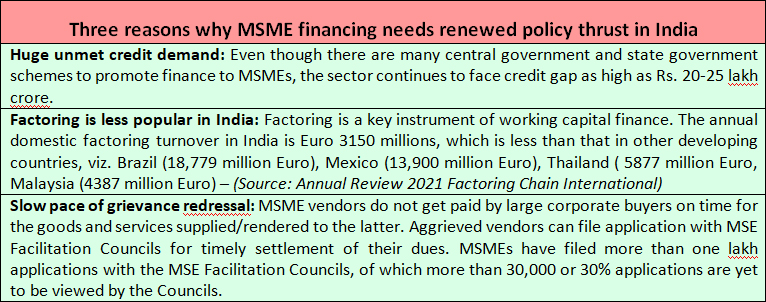The age of digital finance offers fresh hopes and promise to bridge the unmet credit needs of micro, small and medium enterprises (MSMEs), who contribute 30% to India’s GDP,
45% to manufacturing and 48% to merchandise exports of India. As Government of India aims to enhance the share of MSMEs to GDP to 50% in the coming years, there is a need for
policy thrust to address the roadblocks in meeting the credit needs of MSMEs.
Digital lending or loans offered through electronic modes such as mobile apps and online lending marketplaces has been growing in recent years as it is more cost effective,
less time consuming compared to traditional modes of lending. Even traditional lenders such as banks and non banking finance companies (NBFCs) are adopting digital
technologies to reach the unbanked MSME borrowers.
The share of digital lending in the total loan disbursed by NBFCs has grown from 0.55% to 10% since 2017, while the corresponding share for banks grew from 0.3% to 2.07%.
There are several fintech companies that offer online marketplace to connect borrowers and financiers, provide cutting edge credit risk assessment tools and facilitate
seamless loan collection methods for traditional lenders. Such innovation in digital lending facilitates access to collateral-free loans for MSMEs with least paper work
and shorter credit disbursement cycle.
Today, 90% of the formal credit to MSMEs is disbursed by scheduled commercial banks (SCBs), who incur huge cost and time on new customer acquisition and disbursement of
loan because of low ticket size and difficulty in assessing the books of accounts of small enterprises. Digital lending tools such as mobile apps and online marketplace
are reducing the cost of identifying new MSME borrowers and improves ease of credit risk assessment using tools such as artificial intelligence and machine learning.
In this context of remarkable growth in digital lending ecosystem, MVIRDC World Trade Center Mumbai released a study on “Enhancing MSME Competitiveness through
Digital Modes of Financing”.

The study has been conducted with extensive interaction with experts from academia, financial institutions, fintech entrepreneurs and technology evangelists. The study is an attempt to assess the recent developments in the area of digital finance and it proposes roadmap for future evolution of the digital finance industry to consolidate the gains achieved in MSME financing. The report offers around 10 policy suggestions to support growth of the digital lending ecosystem. Some of the suggestions are: encouraging reverse factoring, revising capital adequacy norms for banks’ exposure to invoice financing under TReDS platform, increasing the permissible credit limit that can be disbursed based on Aadhar eKYC and increasing eMandate limit under UPI to enable seamless loan collection.
We hope the study will serve as a useful source of reference for policymakers, financial sector regulators, academia and industry.

 : +91 7718886506
: +91 7718886506